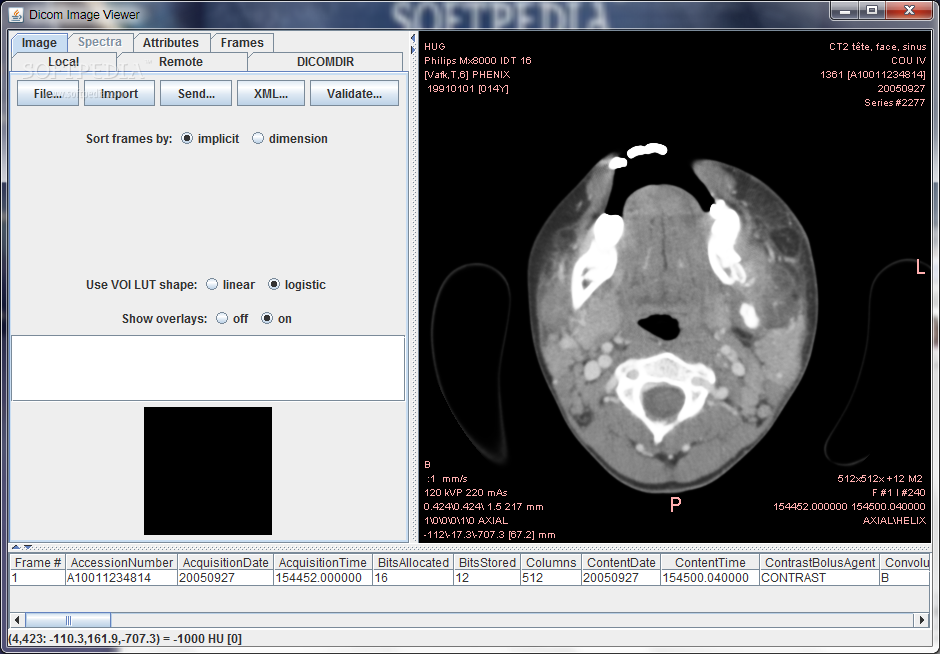dcmmkdir: Create a DICOMDIR file
A Example of DICOMDIR File Content. Which is simply intended to help the reader better understand the organization of a DICOM Directory stored in a DICOMDIR File. A DICOM file is a Digital Imaging and Communications in Medicine Format Bitmap file. Learn how to open a DICOM file or convert one to JPEG, GIF, etc.
$ man 1 dcmmkdir
NAME
dcmmkdir - Create a DICOMDIR fileSYNOPSIS
DESCRIPTION
The dcmmkdir utility creates a DICOMDIR file from the specified referenced DICOM files according to the DICOM Part 11 Media Storage Application Profiles.
Currently the following profiles are supported (others might be added later):
processing options
output options
NOTES
All files specified on the command line (or discovered by recursivly examining the contents of directories with the +r option) are first evaluated for their compatibility with the specified Media Storage Application Profile (Part 11). Only appropriate files encoded using one of the allowed Transfer Syntaxes will be accepted. Files having invalid filenames will be rejected (the rules can be relaxed via the +m option). Files missing required attributes will be rejected (the +I option can relax this behaviour).
A DICOMDIR file will only be constructed if all files have passed initial tests.
The dcmmkdir utility also allows to append new entries to and to update existing entries in a DICOMDIR file. Using option +A new entries are only appended to the DICOMDIR, i.e. existing records like the ones for PATIENT information are not updated. Using option +U also existing records are updated according to the information found in the referenced DICOM files. Please note that this update process might be slower than just appending new entries. However, it makes sure that additional information that is required for the selected application profile is also added to existing records.
The support for icon images is currently restricted to monochrome images. This might change in the future. Till then, color images are automatically converted to grayscale mode. The icon size is 128*128 pixels for the cardiac profiles (as required by the DICOM standard) and 64*64 for all others.
LOGGING

The level of logging output of the various command line tools and underlying libraries can be specified by the user. By default, only errors and warnings are written to the standard error stream. Using option --verbose also informational messages like processing details are reported. Option --debug can be used to get more details on the internal activity, e.g. for debugging purposes. Other logging levels can be selected using option --log-level. In --quiet mode only fatal errors are reported. In such very severe error events, the application will usually terminate. For more details on the different logging levels, see documentation of module 'oflog'.
In case the logging output should be written to file (optionally with logfile rotation), to syslog (Unix) or the event log (Windows) option --log-config can be used. This configuration file also allows for directing only certain messages to a particular output stream and for filtering certain messages based on the module or application where they are generated. An example configuration file is provided in <etcdir>/logger.cfg).
COMMAND LINE
All command line tools use the following notation for parameters: square brackets enclose optional values (0-1), three trailing dots indicate that multiple values are allowed (1-n), a combination of both means 0 to n values.
Command line options are distinguished from parameters by a leading '+' or '-' sign, respectively. Usually, order and position of command line options are arbitrary (i.e. they can appear anywhere). However, if options are mutually exclusive the rightmost appearance is used. This behaviour conforms to the standard evaluation rules of common Unix shells.
In addition, one or more command files can be specified using an '@' sign as a prefix to the filename (e.g. @command.txt). Such a command argument is replaced by the content of the corresponding text file (multiple whitespaces are treated as a single separator unless they appear between two quotation marks) prior to any further evaluation. Please note that a command file cannot contain another command file. This simple but effective approach allows to summarize common combinations of options/parameters and avoids longish and confusing command lines (an example is provided in file <datadir>/dumppat.txt).
ENVIRONMENT
The dcmmkdir utility will attempt to load DICOM data dictionaries specified in the DCMDICTPATH environment variable. By default, i.e. if the DCMDICTPATH environment variable is not set, the file <datadir>/dicom.dic will be loaded unless the dictionary is built into the application (default for Windows).
The default behaviour should be preferred and the DCMDICTPATH environment variable only used when alternative data dictionaries are required. The DCMDICTPATH environment variable has the same format as the Unix shell PATH variable in that a colon (':') separates entries. On Windows systems, a semicolon (';') is used as a separator. The data dictionary code will attempt to load each file specified in the DCMDICTPATH environment variable. It is an error if no data dictionary can be loaded.
SEE ALSO
dcmgpdir(1)
COPYRIGHT
Create Dicomdir From Dicom Files
Copyright (C) 2001-2010 by OFFIS e.V., Escherweg 2, 26121 Oldenburg, Germany.